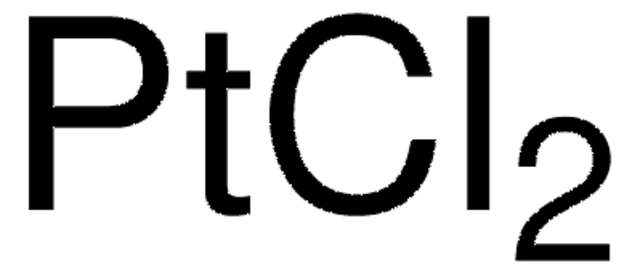520632
Platinum(II) chloride
≥99.9% trace metals basis
Synonym(s):
Platinum dichloride
About This Item
Recommended Products
Quality Level
Assay
≥99.9% trace metals basis
form
powder
reaction suitability
reagent type: catalyst
core: platinum
impurities
≤1000.0 ppm Trace Metal Analysis
mp
581 °C (dec.) (lit.)
density
6.05 g/mL at 25 °C
SMILES string
Cl[Pt]Cl
InChI
1S/2ClH.Pt/h2*1H;/q;;+2/p-2
InChI key
CLSUSRZJUQMOHH-UHFFFAOYSA-L
Looking for similar products? Visit Product Comparison Guide
General description
Application
- As a precursor to synthesize Pt nanoparticles.
- To fabricate Ag-nanostructured grid transparent conductive electrodes.
- As a catalyst for intramolecular C−N bond addition of amides to alkynes.
- As a catalyst for cycloisomerization reactions of hydroxylated enynes.
Signal Word
Danger
Hazard Statements
Precautionary Statements
Hazard Classifications
Eye Dam. 1 - Resp. Sens. 1 - Skin Corr. 1B - Skin Sens. 1
Storage Class Code
8A - Combustible corrosive hazardous materials
WGK
WGK 2
Flash Point(F)
Not applicable
Flash Point(C)
Not applicable
Personal Protective Equipment
Choose from one of the most recent versions:
Certificates of Analysis (COA)
Don't see the Right Version?
If you require a particular version, you can look up a specific certificate by the Lot or Batch number.
Already Own This Product?
Find documentation for the products that you have recently purchased in the Document Library.
Customers Also Viewed
Articles
Plasmonic nanoparticles have unique optical properties that can be tailored to suit a variety of applications in the biotechnology1–8 and electronics9–16 industries.
Our team of scientists has experience in all areas of research including Life Science, Material Science, Chemical Synthesis, Chromatography, Analytical and many others.
Contact Technical Service










